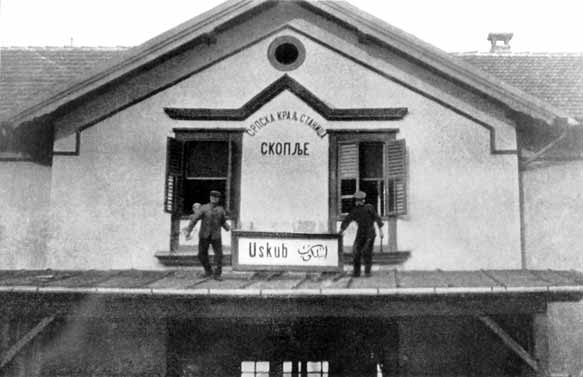|
Tumba Madžari
Tumba () is a Neolithic settlement located in the north-eastern part of Skopje, North Macedonia and it is the most significant Neolithic settlement in Skopje valley. It was discovered in 1961/2 in the course of the archaeological trial excavations related to the construction of the motorway. The first archaeological excavations were conducted in 1978 by the Museum of Macedonia, under the leadership of Voislav Sanev. The stratigraphy of the settlement has a cultural layer that indicates life was continuously taking place in the period between year 6000 and 4300 BC. The land was used mostly for agriculture, conserving the remains of a multifaceted settlement. The evidence of the multiple stages of the settlement is found within a three-foot layer which shows the three stages of life within the community and that the settlement was part of the Anzabegovo-Vršnik cultural group. One of the first structures found was a house, believed to be a sanctuary, demonstrating evidence for reli ... [...More Info...] [...Related Items...] OR: [Wikipedia] [Google] [Baidu] |
Neolithic
The Neolithic or New Stone Age (from Ancient Greek, Greek 'new' and 'stone') is an archaeological period, the final division of the Stone Age in Mesopotamia, Asia, Europe and Africa (c. 10,000 BCE to c. 2,000 BCE). It saw the Neolithic Revolution, a wide-ranging set of developments that appear to have arisen independently in several parts of the world. This "Neolithic package" included the History of agriculture, introduction of farming, domestication of animals, and change from a hunter-gatherer lifestyle to one of sedentism, settlement. The term 'Neolithic' was coined by John Lubbock, 1st Baron Avebury, Sir John Lubbock in 1865 as a refinement of the three-age system. The Neolithic began about 12,000 years ago, when farming appeared in the Epipalaeolithic Near East and Mesopotamia, and later in other parts of the world. It lasted in the Near East until the transitional period of the Chalcolithic (Copper Age) from about 6,500 years ago (4500 BCE), marked by the development ... [...More Info...] [...Related Items...] OR: [Wikipedia] [Google] [Baidu] |
Skopje
Skopje ( , ; ; , sq-definite, Shkupi) is the capital and largest city of North Macedonia. It lies in the northern part of the country, in the Skopje Basin, Skopje Valley along the Vardar River, and is the political, economic, and cultural center of the country. As of the 2021 North Macedonia census, 2021 census, the city had a population of 526,502. Skopje covers 571.46 km² and includes both urban and rural areas, bordered by several Municipalities of North Macedonia, municipalities and close to the borders of Kosovo and Serbia. The area of Skopje has been continuously inhabited since at least the Chalcolithic period. The city — known as ''Scupi'' at the time — was founded in the late 1st century during the rule of Domitian, and abandoned in 518 after an earthquake destroyed the city. It was rebuilt under Justinian I. It became a significant settlement under the First Bulgarian Empire, the Serbian Empire (when it served briefly as a capital), and later under the Otto ... [...More Info...] [...Related Items...] OR: [Wikipedia] [Google] [Baidu] |
North Macedonia
North Macedonia, officially the Republic of North Macedonia, is a landlocked country in Southeast Europe. It shares land borders with Greece to the south, Albania to the west, Bulgaria to the east, Kosovo to the northwest and Serbia to the north. It constitutes approximately the northern third of the larger geographical Macedonia (region), region of Macedonia. Skopje, the capital and largest city, is home to a quarter of the country's population of over 1.83 million. The majority of the residents are ethnic Macedonians (ethnic group), Macedonians, a South Slavs, South Slavic people. Albanians in North Macedonia, Albanians form a significant minority at around 25%, followed by Turks in North Macedonia, Turks, Romani people in North Macedonia, Roma, Serbs in North Macedonia, Serbs, Bosniaks in North Macedonia, Bosniaks, Aromanians in North Macedonia, Aromanians and a few other minorities. The region's history begins with the Paeonia (kingdom), kingdom of Paeonia. In the la ... [...More Info...] [...Related Items...] OR: [Wikipedia] [Google] [Baidu] |
List Of World Heritage Sites In North Macedonia
The United Nations Educational, Scientific and Cultural Organization (UNESCO) World Heritage Sites are places of importance to cultural or natural heritage as described in the UNESCO World Heritage Convention, established in 1972. Following the breakup of Yugoslavia, the Socialist Republic of Macedonia declared independence as Republic of Macedonia in 1991 and succeeded the UNESCO convention on 30 April 1997 under the name the former Yugoslav Republic of Macedonia (due to the naming dispute with Greece). Following the Prespa agreement, the name of the country was officially changed to North Macedonia in 2019. , there are two sites in North Macedonia inscribed on the list and further four on the tentative list. Natural and Cultural Heritage of the Ohrid region was inscribed at the 3rd UNESCO session in 1979. In 2019, the site was expanded to include the Albanian portion of the lake, thus becoming a transnational site. In 2021, the Ancient and Primeval Beech Forests of the Car ... [...More Info...] [...Related Items...] OR: [Wikipedia] [Google] [Baidu] |



